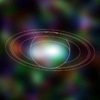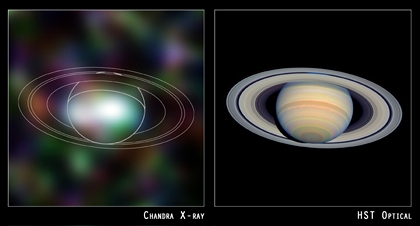X-rays from Saturn Pose Puzzles
Chandra's image of Saturn held some surprises for the observers.First, Saturn's 90 megawatts of X-radiation is concentrated near the equator. This is different from a similar gaseous giant planet, Jupiter, where the most intense X-rays are associated with the strong magnetic field near its poles.
Saturn's X-ray spectrum, or the distribution of its X-rays according to energy, was found to be similar to that of X-rays from the Sun. This indicates that Saturn's X-radiation is due to the reflection of solar X-rays by Saturn's atmosphere. The intensity of these reflected X-rays was unexpectedly strong.
Further observations should help clarify the nature of Saturn's X-radiation, and determine whether Saturn's magnetic polar regions ever flare up in X-rays, as do Jupiter's. The features outside of Saturn's disk in the X-ray image are instrumental artifacts or "noise".
The optical image of Saturn is also due to the reflection of light from the Sun - visible wavelength light in this case - but the optical and X-ray images obviously have dramatic differences. The optical image is much brighter, and shows the beautiful ring structures, which were not detected in X-rays. This is because the Sun emits about a million times more power in visible light than in X-rays, and X-rays reflect much less efficiently from Saturn's atmosphere and rings.
|
||||||||||||||||||||||||||||





